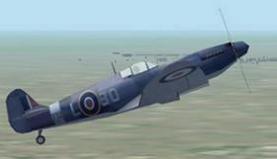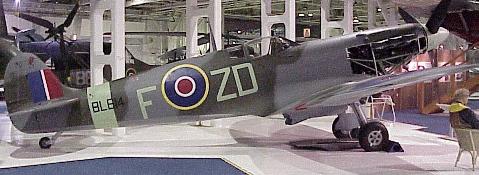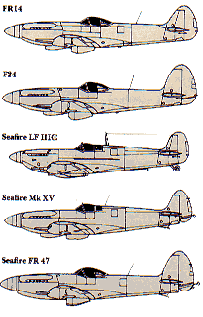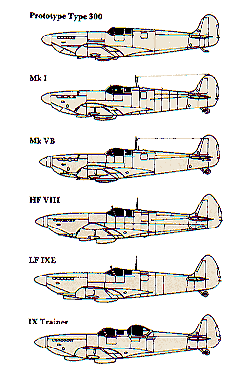

To the British, the Spitfire was more than an aeroplane; it was a symbol. After the fall of France, when Britain stood alone and Germany was poised to launch a massve invasion across the English Channel, Britain's only protection seemed to be a handful of Spitfires and their incredibly brave pilots.
This was quite untrue, because at that time Fighter Command had many more Hawker Hurricanes in service than Spitfires, and they performed just as well as their more illustrious counterparts. But, that said, the Spitfire proved to have far more potential for development. It was perhaps the finest fighting aeroplane of World War II, if not of all time.
So much has been written about the Spitfire and its rightful place in history that it would serve little purpose to add yet more glowing, impassioned passages to the legend. Instead, we will take a factual look at this marvellous aeroplane, from its inception to its final days in post-war service.
Like so many aircraft, the Spitfire was a response to a need. That this need was recognised by only a few, not least its designer,Reginald Mitchell, makes the Spitfire's early history all the more remarkable.
In Britain, the early I 930s was a time not merely of peace, but of a wish to disarm and certainly not invent new weapons. With hindsight, it is easy for historians to see the obvious pointers to World War II, but at the time, politicians and other opinion formers were all desperately trying to paper over the cracks in international harmony. In Britain there was no way that large sums could be committed to a military aircraft programme.
Money was being spent on aircraft design in the United States and Germany where stressed-skin metal construction was leading to faster and more efficient bombers and passenger-carrying aircraft. The casual observer could have been forgiven for thinking that, in I 930, the only advanced technology in the British aircraft industry was concerned with the next year's Schneider Trophy race, which had popular appeal comparable with winning the World Football Cup today.
By I 934 plans were well advanced in Germany for a single-seat fighter that would prove to be one of the most significant weapons of the conflict to come - the Messerschmitt Bf 109. In the Soviet Union the Polikarpov - 16 already existed and almost all other advanced countries were issuing specifications for equally advanced single-seaters.
It was then, in the summer of I 934, that the British aircraft industry woke up. At the Air Ministry young Squadron Leader Ralph Sorley worked out that future fighters would need eight machine guns. And at VickersSupermarine, Reginald Mitchell tore up his program to improve the F.7/30 Spitfire, which was already flying, and began the design of a completely new single-seat fighter, the Type 300, which would eventually also be named the Spitfire.
Mitchell had designed the S.S, S.6 and S.6B seaplanes that had won the final three Schneider Trophy races, bringing the trophy to Britain for keeps. This experience helped, but the real keys to the success of his new fighter lay in different directions.
First was his choice of powerplant. The Rolls-Royce P.V. I 2, later named Merlin, prompted him to design the smallest airframe that could be accommodated around it. More important, perhaps, was his choice of wing aerofoil section, the NACA 2200. Wind-tunnel tests as early as 1927 had shown him that this section, coupled with an elliptical plan-form, would give the low drag characteristics necessary for a world-beating fighter design.
In March I 936 Mitchell's Spitfire made its first flight, from what is today Southampton airport. It was a winner from the start. Within four months the Royal Air Force had placed an initial order for 310 aircraft. At first, production was painfully slow. Supermarine had to divide their time between the Spitfire and the Stranraer and Walrus flying boats, and were designing a large bomber. Moreover the 'Spit' was difficult to make, and Britain had not yet realised they were likely to go to war.
As late as August I 938, when it entered service, many elements within the RAF were undecided about the value, and the potential, of the Spitfire. The Hawker Hurricane, superficially similar but designed along more conventional lines, being larger and of traditional technology, had beaten the Spitfire into service. It was much easier to make and to repair, and was considered by many to be superior. The Spitfire eventually answered its critics effectively.
The Spitfire Mk I, of which more than 1500 were built at Southampton, was powered by the Rolls-Royce Merlin II which developed 1O3Ohp. Armament was at first only four 0.303in Browning machine guns, but after the start of the war all eight were fitted. From autumn 1940 a few had four Brownings and two Hispano 20mm cannon, which became standard on most later versions. A further 920 Mark I's were built at Castle Bromwich, near Birmingham. Like many Mk I's some had the I I 70 hp Merlin XII. These helped to see Britain through the dark days of 1940 and, in the early months of I 941, began to take the air war back across the English Channel to France.
Further developments into specialised high-altitude and photo-reconnaissance versions followed, alongside continuous development of the Merlin engine. The Spitfire certainly proved more than a match for its main rival, the Messerschmitt Bf 109. The German mainstay could out-climb, out-dive and equal the Spitfire for sheer speed at low altitudes (below 20,OOOft). But it was less manoeuvrable and the early Spitfires' superior rate of turn enabled them to hold their own in a dogfight.
During 1941, Spitfire pilots, now flying the1440hp Merlin 45 powered Mk V, found that they were being out-fought by a completely unknown adversary with a radial engine. This was eventually identified as the Focke-WuIf Fw 190.
By sheer chance, Rolls-Royce had already produced a totally new Merlin, the Mk 61, with two superchargers in tandem. At high altitudes it gave double the power of the Spitfire I engine. This new engine was rushed into production and fitted to the Spitfire V, turning it into the Mk IX, with 4-blade propeller, long nose, twice as many exhaust stubs and twin underwing radiators. The Mk IX took on the FWw190 and won.
The Spitfire, in all its 22 different Marks continued to be built until March I 948. By then no less than 20,346 aircraft (excluding prototypes) had been built. Alongside the Spitfires were Seafires, flown from aircraft carriers by the Fleet Air Arm.
Symbol of a nation's courage, there will never be an aircraft like it.
SUPERMARINE SPITFIRE: Influenced by his successful Schneider Trophy seaplanes, R.J. Mitchell produced his classic Spitfire design to meet a 1934 fighter requirement, the prototype being first flown in 1934 and displaying impressive performance. Unlike its counterpart, the Messerscmitt 109, it was not really de-signed for mass production.
Made of metal stressed skin construction with fabric covered control surfaces, the Spitfire was of exceptionally clean lines with elliptical wings but definitely hampered with a narrow track landing gear. Never-the-less, more Spitfires of all types were produced than any other British aircraft until 1947: the total was over 20,000.
Spitfire Mk IX in CFS2
This is a CFS stock Spitfire imported into Microsoft Combat Flight Simulator 2.
Spitfire Mk IX in CFS2
The Spitfire proved,like the Bf 109, to be a very adaptable airplane, and in various versions it served throughout the war. Naturally, most of the famous British aces of WW II flew the Spitfire, including the top scoring British ace of the war Group Captain "Johnny" Johnson (38 victories), and the legless ace and hero of the Battle of Britain, Douglas Bader (he flew with two artificial legs).The Spitfire evolved from the Supermarine line of Schneider Trophy (seaplane) racers of the late 1920's and early 1930's, which culminated in the trophy winning S.6B of 1931. In September of that year, the S.6B captured the Trophy with a top speed of 340.8 m.p.h., and set a world speed record of 407 m.p.h.
The prototype Spitfire was built in 1936. Like the Bf 109, and all of the other "best" fighters the Spitfire was an all metal stressed-skin monoplane. This was new technology at that time, and many production problems had to be solved, which resulted in considerable delays before the new fighter began reaching RAF squadrons.The first production version was the Mk I, which entered squadron service in mid-1938. When the war came in 1939, the RAF insisted in holding the bulk of their modern monoplane fighters in Britain, sending only a few of the modern Hurricanes, and no Spitfires, to France. This proved to be a good decision as, after the fall of France, RAF fighter command could deploy about 620 Hurricanes and Spitfires to meet the Luftwaffe's 800 Bf 109s. The Luftwaffe also had about 275 Bf 110 twin engine "Destroyer" fighters, but these proved to be no match for the single engine British fighters.
The main variant of the Spitfire Mk IA was powered by the famous Rolls Royce V-12 Merlin II engine. This produced 1,230 h.p. and drove a two bladed wooden propeller, giving the early Spitfire a top level speed of about 360 m.p.h., and a best climb rate of 2,530 ft/min. By the time of the battle of Britain, a three-bladed constant speed propeller, which markedly improved climb and acceleration, had been fitted.
Typical armament of both Spitfires and Hurricanes of this period was 8-.303 cal Browning machine guns, four in each wing. Some Spitfires were fitted with 2-20mm cannon plus a couple of machine guns, and these were called Mk IB's.
Either way, their performance was closely similar to that of the Bf 109E, with the Spitfire being more maneuverable, and the Messerschmitt being faster in the dive, and with a higher roll rate.
In 1940 the Mk II began to appear, and replaced the Mk I in early 1941. The Mk II was powered by a 1,240 h.p. Merlin XII, which gave it a top speed almost identical to the Mk I (354 m.p.h. at 17,550 ft), but a higher rate of climb (3,025 ft/min). It is worth mentioning that all Spitfire versions had carburetors, not fuel injection, and the engines would quit for lack of fuel if the aircraft was flown upside down. Mk II's were also armed with either eight machine guns, or a mix of machine guns and cannons. All Spitfires of this period had the signature elliptical plan wings.
History records that these Spitfires (and Hurricanes) prevailed in the Battle of Britain. Their primary shortcoming, again like the Bf 109, was their short range. This was not a problem while they were serving in the interceptor role during the Battle of Britain, but it became a glaring fault when the RAF went over onto the offensive.
Later marks of Spitfire included the Mk V of 1941, which for the first time introduced "clipped" wing tips to increase the roll rate. The Mk V had a top speed of up to 374 m.p.h., but had begun to fall behind the Bf 109F in overall performance, a problem that intensified when the Germans introduced the FW 190 fighter . Best rate of climb was 2,900 ft/min. The Mk V probably represents the low point of the Spitfire v.s. the top German fighters.
The next big production model was the Mk IX, a Mk V airframe with a new two stage, two speed, supercharged Merlin 70 engine, which developed 1,655 h.p. at 10,000 ft. This new engine was really intended for the all new Spitfire Mk VIII airframe, but the press of events forced its adoption in the older airframe. The result, however, was quite satisfactory. Top speed was raised to 415 m.p.h. at 27,800 ft. Best climb rate jumped to 4,530 ft/min. The Mk IX started to enter service around the middle of 1942, and proved able to meet the German fighters on an essentially equal footing. The elliptical wing plan returned in the Mk IX, which was approximately contemporary to the Bf 109G, and like that fighter, served for the rest of the war.
The Mk VIII finally came along in 1943, incorporating many detail improvements, including better streamlining and a fully retractable tail wheel. Best climb rate was 3,790 ft/min. This version was used mostly in the Far East, later in the war.
The final major models were the Mk XIV of 1944, and the Mk 22 of 1945. The Mk XIV was a Mk VIII airframe with a Rolls Royce Griffon engine, developing 2,035 h.p., good for a top speed at altitude of 439 m.p.h. It drove a five bladed propeller and gave the Mk XIV an improved service ceiling and enhanced high altitude performance, to match the latest German fighters. Best climb rate was up to 4,700 ft/min. Later Mk XIV's also had a "teardrop" style canopy to improve all-around visibility.
The Mk 22 was the last Spitfire, also with a teardrop canopy, and for the first time the wing was redesigned. The new wing was similar in plan, but was stronger, carried more fuel, housed a longer landing gear (which allowed a larger diameter propeller), and carried four 20mm cannon. Speed was up to 450 m.p.h., and best climb rate up to 4,900 ft/min. The Spitfire had reached the end of its long career. The future would belong to more modern fighters, but by this time the war was ending anyway, and the jet age had begun.
Following are the basic specifications for the Spitfire IIA, of September 1940.
Wingspan: 36ft 10in
Length: 29ft 9in
Height: 8 ft. 10 in.
Wing area: 242 sq. ft.
Engine: R.R. Merlin XII, 12 cyl. Vee, 1,236 h.p.
Max speed: 354 m.p.h. at 17,559 ft.
Best climb: 3,025 ft/min at 12,800 ft.
Climb to: 10,000 ft., 3.4 min; 20,000 ft., 7 min.
Service ceiling: 37,600 ft.
Combat range: 395 miles
Empty weight: 4,783 lb..
Loaded weight: 6,172 lb..
Armament:
8-.303in Browning MG (4/wing)


The changing shape of the Spitfire; not only did the engines become more powerful, but the canopy was improved to better all-round visibility and a whip antenna replaced the earlier mast. Four of the eight machineguns were replaced by two cannon and aircraft were given underwing points to take bombs or rockets. Despite all these changes the aircraft remained a Spitfire, and one of the best fighters of World War II 

5
Spitfire I Type: interceptor and fighter-bomber Maker: Supermarine Division of VickersArmstrongs Ltd in factories at Southampton, Winchester, Swindon and Castle Bromwich, and numerous subcontractors 1
Span: ll.23m (36ft lOin) Length: 9.l2m (29ft 11 in) Height: 2.69m (8ft 10 in) Wing area: 22.48 m2 (242 sq ft) Weight: maximum 2623 kg (57841b); empty 2102 kg (4810 Ib) Powerplant: one 1030-hp Rolls-Royce Merlin II or III V-12 liquid-cooled engine Performance: maximum speed 571 km/h (355 mph) at 5791 m (19000ft); range 636 km (395 miles) operational ceiling 10363 m (34000ft) Armament: eight 7.7-mm (0.303-in) machine-guns (IA) or four machine-guns and two 20-mm (0.79-in) cannon (IB) Crew: 1 Production: 1583 Mk VC 1Specification similar to Spitfire I except in following particulars: Height: 3.48m (lIft Sin) Weight: maximum 3078 kg (6785 Ib); empty 2313 kg (SIOOlb) 1Powerplant: one 1470-hp Rolls-Royce Merlin 45 V- 12 liquid-cooled engine Performance: maximum speed 602 km/h (374 mph) at 3963m (13000ft);
range:756 km (470 miles);operational ceiling 11 278 m (37 000 ft) Armament: two 20-mm (0.79-in) Hispano-Suiza cannon; four 0.303-in (7.7-mm) Browning machineguns or four 20-mm cannon; 227 kg (500 Ib) of bombs Production: 2447 (6479 all Mk XVI Specification similar to Spitfire I except in the following particulars: Span: 9.98 m (32 ft 8 in) Length: 9.55m (31 ft4in) Height: 3.86m (l2ft8in) Wing area: 23.04m2 (248sqft) Weight: maximum 3311 kg (7300 Ib); empty 2631 kg (5800 Ib) Powerplant: one 1720-hp Packard Merlin 266 liquid- cooled engine Performance: maximum speed 652 km/h (405 mph) at 6706m (22000ft); range 698 km (434 miles); operational ceiling 12 192 m (40 000 ft) Armament: two 20-mm (0.79-in) cannon; four 7.7-mm (0.303-mm) machine- guns; provision for 454 kg (1000 Ib) of bombs or rockets Production: 1054 Mk XIV Specification similar to Spitfire I except in the following particulars: Length: 9.95 m (32 ft 8 in) Height: 3.86m (l2ft8in) Wing area: 22.67 m2 (244 sq ft) Weight: maximum 4663 kg (102801b); empty 2994 kg (6600 Ib) Powerplant: one 2050-hp Rolls-Royce Griffon 65 engine Performance: maximum speed 721 km/h (448 mph) at 7925m (26000ft); range 1368km (850 miles); operational ceiling 13564 m (44500ft) Armament: two 20-mm (0.79-in) Hispano Mk II cannon; two 0.5-in (12.7-mm) Browning machine-guns; provision for 4S4 kg (1000 Ib) of bombs Production: 957 (total Spitfires of all types excluding Seafires 20351)